Juliet Syndrom
A novel by Zoha Kazemi
- Published By Baazh
- Publication Date 2020
- Genre Science Fiction
- Language Farsi
Author
Speculative Fiction

Zoha Kazemi is an Iranian speculative fiction writer, creative writing lecturer and editor. She was born in 1982, in Tehran and is currently living there. She has an engineering BS and an MA in English literature. She started writing and publishing stories since 2011. She writes both in Persian and English. Zoha Kazemi has published 13 novels, a short story collection, and a flash fiction collection in Iran. Her novels “Rain Born” (Austin McCauley Pub.) and “Year of the Tree” (translated by Caroline Croskery, Candle and Fog Publications) are available in English. She has won the Noofe award for the best speculative novel of the year in Iran, two times in a row and has received acknowledgement from Noofe for her first sci-fi novel. She writes in many different science fiction sub-genres like bio-punk, alien invasion, post-apocalypse, time travel, space travel and etc. But she is mostly known for her creative and bold dystopian worldbuilding. She owns a bookshop in Tehran “Rama Bookstore” which is specialized in speculative fiction.

A novel by Zoha Kazemi

A Novel by Zoha Kazemi
Death Industry
A revolutionary invention by Dr. Ambrose has changed the country. His quantum computer can determine the exact date of everyone’s death. This date is written on people’s birth/death certificates and classifies them according to their life spans. Those who die before the age of 20 (little travelers) are separated from their families from birth and kept in isolated towns to protect the parents from the pain of losing a child. Others are allowed to live in the cities but their death dates determine the services they receive from the government. Those who die under 30 won’t be accepted in universities and therefore can only apply for low payment labor jobs. On the other hand, full life citizens can have it all! A new religion has formed to ease the life of people and give more clarification and a sense of judgment and equality to people. The priests of Ambrose Temple have infused and corrupted the government and have power over the people. The Ambrose temple has also constructed a new calendar based on the Ambrose processor. The year is 221 when the story begins.
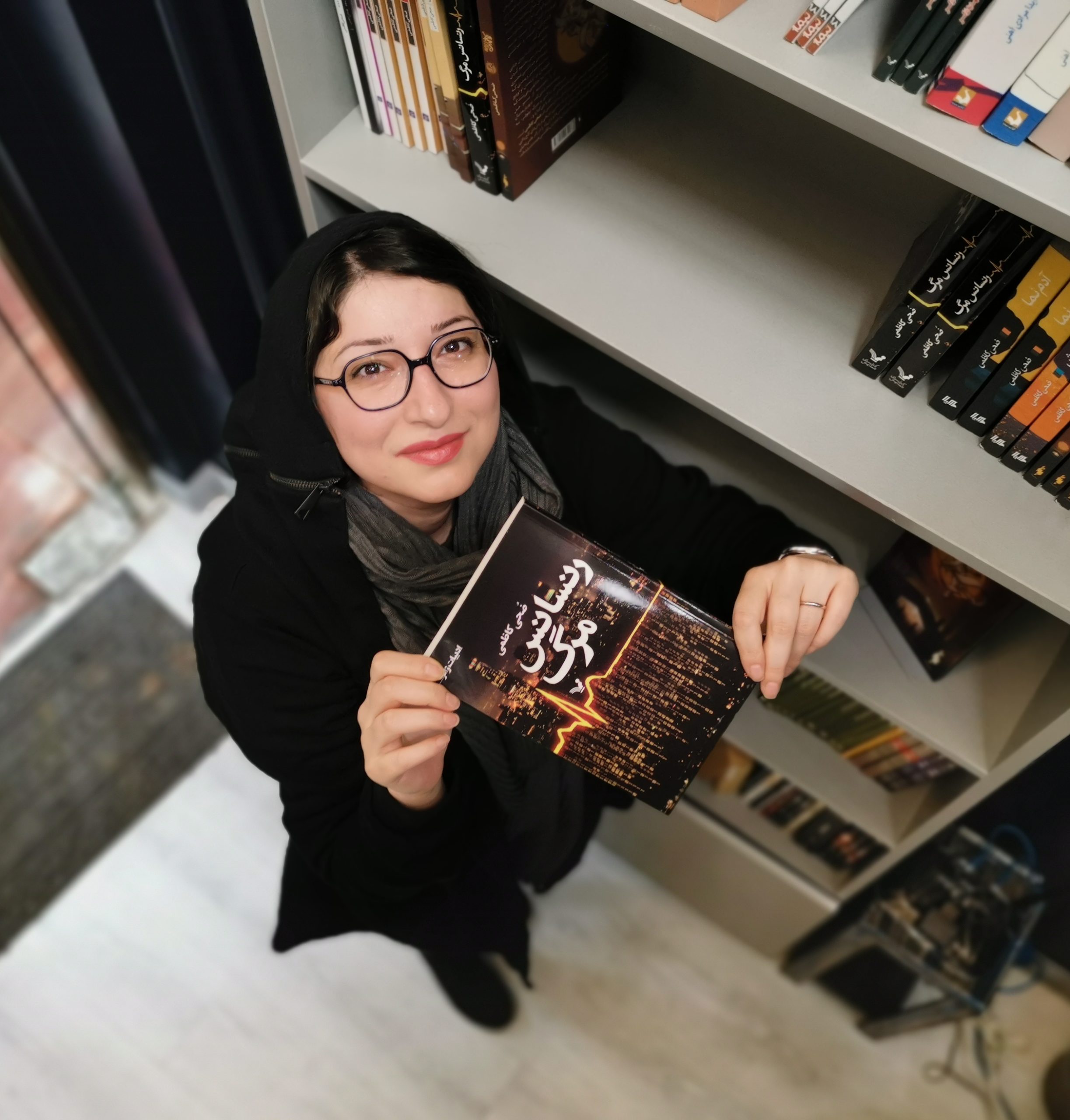

A Short Story Collection by Zoha Kazemi

“Time Rider” is a collection of nine speculative short stories, published in Iran by Tandis Books on October 2021 and includes a preface written by Behzad Ghdimi– the known Iranian speculative writer, and each story comes with an illustration by Mahour Pourghadim.
The book was well received by the Iranian audience.
The stories are written in different science fiction sub-genres such as dystopia, bio-punk, alien invasion, generation ships, post-apocalypse, time travel, space travel and etc. They engage the readers with deep and touching themes such as love, death, hope, loneliness, despair and …
Isolation: 4300 words

The first story of the collection is written in the sub-genre of bio-punk and deals with the themes of isolation and the deep and bitter feeling of human touch deprivation. It examines the virtual reality as the new reality that tries to substitute the lost natural life and human contact.
“Isolation” takes place many years in the future. Due to a genetic defect, humans are allergic to other human DNAs and if in contact, they will show an anaphylaxis reaction and die. They live in isolated cells and spend most of their time in virtual reality. Sayeh is a scientist that leads the experiments carried out on specific children with marked DNAs, hoping to find a cure for the anaphylaxis defect. After decades of experimentation and losing so many children to the tests, they have finally achieved results: nine test subject couples were able to stay alive in the same room and not show any allergic symptoms.
Sayeh anxiously watches the tenth couple come in contact in the test room. She is scared to see the couple go into allergic shock and die in front of her. She closes her eyes and opens them as she hears the loud cheering from the test team (each in their own isolated rooms). She sighs with relief since the results are finally confirmed and assertive. But Sayeh feels a great hole inside of her. She knows the next generation can be free of the isolated cells and go back to their natural way of life but it is already too late for her generation. She visits her boyfriend in the VR and they both talk about the great breakthrough and the celebrations that are going to be held. Sayeh seems sad and broken. She is deprived of human touch forever; the only thing that she believes makes her real. All she wants is to touch and feel another human being in reality, not VR or from behind the many layers of isolated suits.
Sayeh asks her boyfriend to come and meet her in the test rooms of the lab…
Skinner: 4000 words

“Skinner” is written in the sub-genre of alien invasion and explores the theme of invasion as an act of rape and assault. It also shows how people deal with a situation that seems to be dead end. “Hope” may be the only natural instinct that keeps the survivors alive.
In a near future, aliens invade earth. Upon their arrival, they destroy all the communication systems and bring down the power. Therefore earth becomes dark and disconnected. People are trapped in their home towns with no electricity, water, gas and other utilities. The towns have a post-apocalyptic outlook and it’s not going to take long before people start tearing each other apart for food and water.
Siavash, a young photographer and the narrator of the story, leaves his flat to go to the alien landing place outside of Tehran. He has heard that no one has come out of the area alive but he prefers to see the aliens and be killed by them, rather than wait for people to turn into zombies, killing each other for food and necessities. As he steps out, his girlfriend Yassi is waiting for him. Yassi wants to come along and Siavash can’t stop her. They follow the rout that Yassi had found, climbing the Darabad Mountain and going down the northern alley to the landing place.
As they arrive at the mountain ridge, they see the weird structure made by the aliens. It looks like a giant black bee hive. They camp there for the night and try to have fun on their supposedly last night, but it turns bad for Yassi as Siavash doesn’t listen to her and rapes her. The next morning, Yassi is still upset. They go down the mountain and walk by the emptied roads and villages until they see the giant flying aliens that are wearing clothes made by different pieces of human skin, stitched together.
Siavash and Yassi are captured by the aliens…
Time Rider: 4100 words

The third story of the collection “Time Rider” shares the title of the book. It is written in the sub-genre of time-travel and apocalyptic stories. It has a romantic tone to it and it uses the form of love letters to tell the story.
Time-riders come from future and are searching the whole history to find what causes a deadly pandemic that kills many people on earth. They recruit people from the twenty first century and send them back and forth to specific places and points in time to find a clue. Those who go forward in the future can move through time with their bodies but the past-riders leave their bodies in the capsules and appear in the past as whispers.
The story is written in the form of three letters written by two colleague/secret lovers. In the first letter, the writer expresses his love to his lover saying that their missions will end shortly and for their last mission they can finally be together as they are both being sent to the future. He also says he has brought her a precious gift and explains where it is hidden. This letter has a very romantic tone and indirectly explains how the time-riders operate.
The second letter is from the female lover to the writer of the first letter. She says she has found the precious Sassanid necklace and explains how this necklace was the source of the deadly pandemic. According to her the frozen necklace had kept the deadly virus alive and hidden through centuries and after it was unfrozen, it spread fast. She also mentions that everyone has died including her lover (the writer of the first letter). The third letter is found among the Sassanid necklace. It is written by the writer of the first letter and explains how he managed to bring back the Sassanid necklace to the present time. The letter explores the time of the Sassanid defeat from the Muslim army and notes that there were two deadly plagues at the time.
Time Rider is a complex story that combines science fiction with romance and historical events. It has a special prose, combining the tones of romantic stories with hard science fiction.
The Blue Dusk 1800 words

This story takes place on Mars in a near future. The first crew of the Mars establishment project are sent there to start building the foundations of the future settlement and wait for other groups of humans to arrive.
Sahar is an orthopedic doctor and the only crew member from the Middle East. After an explosion in the camp, everyone dies except for Sahar and another crew named Lars, who is badly injured and cannot walk.
Sahar is left stranded on Mars. She feels lonely and hopeless. She finds out that the project is cancelled and there will be no more people coming to Mars. Even though she hides this news from Lars, Lars kills himself and Sahar is left alone. She tries to keep herself busy and sane but eventually she loses herself.
The story is narrated by Sahar in a first person point of view. She uses stream of consciousness to go back and forth in time and explain what has happened. Sahar loves contemporary Persian poetry and there are many references to Forough and other poets in her narration. “The Blue Dusk” explores the theme of love, human dependency, loneliness and solitude.
Superstar: 8500 words

This is the longest story of the collection and happens in the near future. It has a mild comedy tone and a noir atmosphere.
Ali, a young writer, wakes up in a weird hospital-like place. He has a metal cap on his head with wires connected to it. He takes out the cap and looks around seeing many people in deep coma, lying on beds connected to similar metal caps and wires. He eventually gets up and covers himself with a sheet. He doesn’t remember why he is there and what happens. All he remembers is bits and pieces about a party and his girlfriend Maryam. He manages to get out of the bunker that has many rooms filled with many unconscious people. When he finally gets out he wanders through the alleys and roads of Tehran. Everything has changed and he eventually finds out that he was asleep for ten years. What amazes him more is seeing large billboards showing the face of “Pishgam” and saying he is the new art genius in the world. Ali remembers Pishgam as Maryam’s professor and doesn’t know how he has become the greatest idle in the city.
He goes to his parents’ house, but they no longer live there and Ali finds out that he was announced dead ten years ago. He goes to the police but they dismiss him saying that he is mad. He starts remembering what happened to him. He had made a deal with Pishgam to take part in an experiment. The experiment was meant to help Ali become more creative but he had never woken up from it. He sets off to the Pishgam Museum that is being advertised all over the town. He wants to confront Pishgam and find answers.
In the museum he runs into Maryam! She has been working for Pishgam all these years. She says Pishgam has a device that helps him create the best genuine art, from fiction books to films, sculpture, painting and etc. Ali takes Maryam to the bunker and wants to show her how Pishgam is stealing other artists’ ideas. Ali believes that artists are put to sleep and Pishgam is accessing their unconscious and making art by using their thoughts, memories and visions. Maryam seems shocked but goes along to see if the claim in true.
In the bunker Maryam seems calm and relaxed and Ali finds out that Maryam has been working for Pishgam from the start, directing Ali to her professor as the next victim…
This story speculates about the true nature of art and the value of creation. It has many references to Iran’s monopoly literary circle that is trying to silence individual voices.
The Hostile Newborn (The Hatching): 1300 words

The Hostile Newborn is a post-apocalyptic story that takes place in the far future. This story has a very strong, detailed and visual world building and explores the theme of human survival and natural evolution.
After a severe climatic change and the melting of icebergs, the world was drowned in water. Only birds and a small population of humans have survived. The birds are evolving day by day and they are getting larger. They are the rulers of the new world and mankind has to hide himself from these giant predators.
A man with two of his sons set off on a dangerous mission to hunt for eggs. The journey is hard and frustrating. They get back to camp safely and victoriously as they have brought three giant eggs for the camp.
They warm themselves by the fire and people attend to their usual choirs that are consistent to their life style, getting ready for the long and wet winter ahead of them. The grandmother starts to make dinner but she finds the egg to be a little off. She is right! The egg is not from a bird, a baby snake breaks the shell and starts attacking the camp.
Exhale: 4000 words

This story takes place in a generation ship that orbits the earth. Each year very few new-comers arrive at the “Serenity Ship” to replace the lost manpower. The population is tightly kept on Serenity and people are not allowed to have babies without authorization.
The story starts in the vacuum. A woman is dying in the space and she is remembering and retelling her story as she is trying to avoid her last exhale.
She was born and raised on Serenity and had fallen in love with a man that had come to their ship a few years ago. Hoping to get permission to have a child with this man, she overlooks all of his unusual and abusive behavior and even helps him cover up his criminal activities. But putting up with the role of the victim doesn’t play well for her.
She witnesses sabotage, stealing and a murder and knows that her boyfriend is behind all of this. She thinks that her boyfriend has used a metallic earth ball to kill the victim and believes it must be the same earth she had at her cabin.
As she stands by the airlock to get rid of the murder weapon, her boyfriend arrives with the real murder weapon and throws her out of the airlock.
The narrator goes back and forth in time, explaining her life on Serenity and her hopes and dreams. She regrets the choice of staying silence against her boyfriend’s abusive behavior.
“Exhale” is written in the sub-genre of space travel and generation ships. It explores the theme of love, marriage, deception and domestic violence.
Guilt: Zero Percent 3400 words

In a near future, people have special devices that can determine and show what emotions they are experiencing and what is the percentage of each emotion. People can read the emotions of others around them. This has led to a reduction of crime rates. Also advanced lie-detector devices help the police and they can catch criminals very easily.
A woman is found dead in her apartment. She was hanged from the ceiling. The police suspects the husband but his emotions do not add up with the emotion criteria of a killer and he apparently has an alibi for the murder time. The husband tells the police that her wife was having an affair with her boss.
The police interviews the boss and he also doesn’t have the emotion criteria of a killer. They use lie-detectors and make sure that the boss is innocent.
The husband kills the boss in a similar way and when the police comes to the scene, he lies about it, saying that the boss was already dead when he arrived. Police finds evidence linking the husband to the murders, but their evidence is not admissible because the lie-detectors and emotion sensors do not back them up. According to the new police criteria based on emotion sensors and lie-detectors, the husband is innocent and goes free.
This story is written in the sub-genre of dystopia and deals with the idea of advanced technology verses unknown human nature. It also explores the theme of love, betrayal and possession.
The Annual Breathing 2400 words

This story takes place in a near future when the earth’s air is not breathable due to over pollution and lack of oxygen. People have to wear oxygen masks all the time outside. Oxygen generators are placed indoors to generate breathable air.
Once a year, the government turns on advanced and expensive massive, super fans to make the city’s air breathable for a few hours. This time is called the Annual Breathing and it is celebration time!
Nahid works in a factory and can hardly afford her oxygen tank and provide for her teenage son. Just before the Annual Breathing, she finally receives her salary and decides to buy new clothes for her son, so he can get out and meet his friends after two years of being inside.
As she finishes her shopping, she has to exchange her oxygen tank and replace it with a new one. A biker approaches her and steals her new tank. She is helpless and without oxygen. As she draws her final breaths she remembers her childhood and reminds herself of all the hopes and dreams she has for her son…
This story, although written in a dystopian setting, speculates about the harsh effects of global warming and carbon dioxide emissions. It also explores the theme of poverty and motherhood.

A Post Apocalyptic Novel by Zoha Kazemi
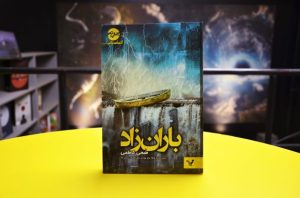
Rain Born
Rain Born takes place many years in the future. After a natural apocalypse, the world is drowned in water and people live on the ships and islands. They have constructed a new religion and a set of rules and have based their political, cultural and economical structure on these beliefs. But these beliefs do not bring prosperity for people. Instead they have made them into victims of the vicious religious leaders who always seek more power and more wealth. It is the people who have to pay for the greed of their leaders by fighting in a war that is based on a lie.
Although people are struggling between their faith and survival, drowned in the complexities of their self-constructed and controlling rules and values, nature is taking its course. Evolution is seeking to select the new, evolved babies that seem to be more compatible with the new water world.
Tirad is one of the disciples that teach the religious Narratives of the Saviour—the man who was the founding symbol of the post-rain world. He is a keen and dedicated follower and a true believer who has decided to ignore the corruption signs and waiver the possibility that his religion is based on no true facts. But in a turbulent path set forth to him by the Saviour Circle, he faces many challenges that shake his rock-hard beliefs; it is a journey of love, loss and fate that changes his destiny.
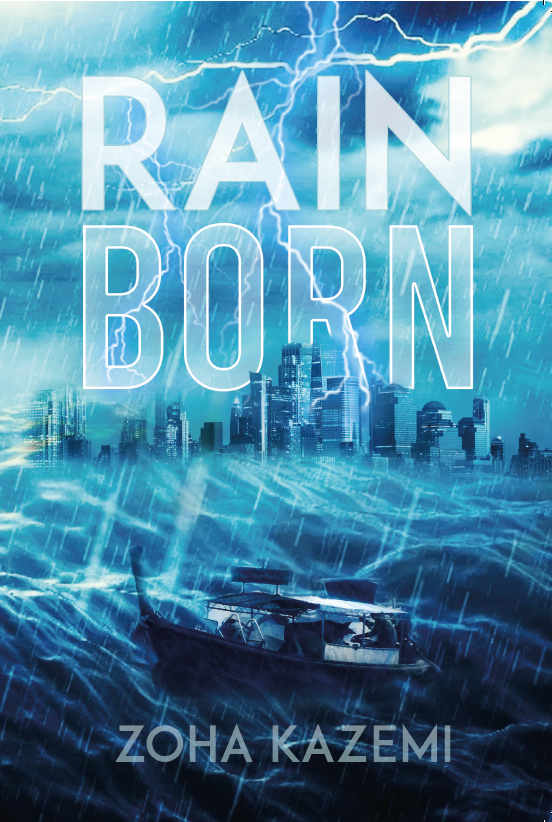

A Dystopian Novel By Zoha Kazemi
Humanoid
Set in a near future after a revolution in stem cells technology, people are literally immortal. They can reproduce and replace their organs and never die from organ failures and fatal diseases. Every 40 years people can choose their professions according to what they like and their performances during their last 40 years of work. They also choose their own names according to their professions. The main character Atwood is a writer who is nearly finishing his 40 years of work as a fiction writer. But his brain cells were tempered and replaced and she has lost some parts of her memory. This is a bad sign that shows she was not a compliant citizen. She tries to find why this surgery was performed on her. But as she starts her quest, the main nuclear plants that supported the power for stem cells banks, explode in a shocking accident. She senses that her memory surgery and the explosions are somehow linked…

A Novel by Zoha Kazemi
The Covering Dust
The Covering Dust takes place in the Elamite era, three thousand years ago; the pre-Iranian civilization centered in the far West and Southwest of what is now modern-day Iran. At the time when inner family marriage was common and the Shatens (monks) ruled over people’s day to day life and cast their shadows on their after-lives. The Gods and Goddesses were considered powerful influences on the acts of men and women and they were the only source of truth and justice.
Haltash, the young son of a passed farmer is madly in love with the girl whom his father took into his care after her father and brothers died at sea. But Haltash’s father does not allow them to marry; he wants Haltash to marry his sister instead. Haltash claims that his father withdrew his will at his death bed. It is now word against word. Haltash’s sister will not do against her father’s will and takes up her claim to the temple of the Sun God (Nahunte) in Susa. Haltash is called in by the court which takes place with the presence of Shatens and the great judge of Susa. The court is not able to decide who is telling the truth. Therefore they entrust the sentence on to Shazi, the goddess of justice, afterlife and the rivers. Haltash is thrown in to the river to come face to face with Shazi. If he comes out alive then he is telling the truth and his sister shall be punished for lying in the court. And if he has lied he shall drown in the river ruled by the goddess of justice.
Haltash escapes death in the river, even though he had actually lied in the court. He struggles on what to do; whether to go back and have her sister punished by the temple or to run away. He finally decides to go and find her lover and to secretly escape with her to another country. But the return journey is not as easy as he expects. After long hours of walking and climbing the arid mountains, he still does not find his way back. In his most hopeless moment he sees light, a mountain side lit by fires coming out of the soil. He is drawn to the fires of Tashkooh where he meets an old man whom he later discovers is immortal. The Old Man tells him his dreadful life story and how the magical soil of Tashkooh can make people immortal. He agrees to help Haltash find his way back to his lover under only one condition: should he return to him, he will have to help him die. And there is only one way that he could kill an immortal.

A Novel by Zoha Kazemi
Pine Dead
A country that has lost many men in a long war comes up with an idea to increase the population. They secretly fertilize the women to give birth to twins and triplets. Women give birth to a lot of babies and the population increase gets out of hand. The new generation is overcrowded with so little facilities. The schools become overcrowded; there is not enough food, medicine and sanitation. This generation is brought up in difficult circumstances. When they become the young adults starting to rule the country, they revolt against the past government and change it through a coup. The first thing they do is to neutralize everyone so they cannot reproduce and have babies. Then they organize people in groups of eight consisting of four couples. Each family is given a baby to nurture. The babies are made synthetically by incubators and carry the mixed genes of their eight parents.
After sometime, the population decreases. Now the new generation is left with a heavy work load and many old people to take care of. The new generation rebels again. This time by spreading a virus that is meant to slowly kill the old parents. The virus is designed to suddenly kill by withering the body. Therefore people fall dead like a pine cone falling off a tree. The virus spreads out of hand, killing the whole population and spreading further to other countries, taking over the world.
There seems to be no hope but a vaccine that is not yet sure to be effective. The whole human race is about to vanish. All Governments provide people with special pens and notebooks and asks them to write down whatever they can so that their life stories may remain as the sign of an intelligent race gone for good. The notebooks and other valuable things are to be sealed in time capsules.
The novel is read through three stories written by three characters in their notebooks, each representing one of the mentioned generations and explaining the events from their perspective. Also the readers travel along with Mahoor, an old man who immediately leaves town to find help. He seeks help from people who had not accepted becoming part of an eight parent family and had escaped many years ago. Through his thrilling journey the readers learn about the past life of the people in the story and the past city…

A Novel By Zoha Kazemi
Has Someone Died Here?
“Has Someone Died Here” is a labyrinthal narration of the lives of six couples whose fates are tied together. They gather and come to meet up in a hospital lobby on a cool summer night. Mahshid’d infant boy is suffering from concussion, Danial’s wife is badly injured in a car crash, Sina’s girlfriend has committed suicide, Maryam’s sister is losing her baby in child birth, Salume’s father is in the fatal stages of his cancer and Adel’s little boy has lost both his kidneys. The main six characters of the story meet with a middle aged man named Edris. They’re meeting takes place in a dream like space and an illusional place, a parallel hospital lobby. Although they all have seen Edris before in their everyday lives, some remember having met him before and some don’t. Edris, awakens the characters in the parallel illusional lobby, one by one. He tells them that if they’re love for their loved one in coma is real and true; they can help bring them back to life. All they need to do is to go through the exact pain and condition of their loved ones. Adel is the only exception; he is only to watch the mysterious scenes and to learn and find a way to help himself and others in future. The characters of the story treat Edris with awe and disbelief. Once the deal of love and death is on the table, some like Mahshid accept the deal without a second thought, most of them hesitate and others like Salume will not go through it at all. It’s a long night and each character has to look in through one’s self, to face their true feelings and decide. This decision is the beginning of an inner deep journey to find ways to help themselves and others. Edris has not chosen these six people randomly. They each have had a peculiar and unique life which is read in the novel in between the awakening chapters. The characters’ struggles and their final decisions, raise many questions and challenges about love, life and death in the reader’s mind. This novel with its numerous special characters, short chapters and diverse attractive scenes, will keep the reader’s read on till the end.

A Novel By Zoha Kazemi
Year of the Tree
Year of the Tree is an intertwined story of the downfall of three generations of three Iranian families who undergo many losses, fears and doubts. It’s the bitter story of people longing to find happiness and peace, people who fight against destiny for their faith, love, wealth and families.
From the book:
“The sound of footsteps in the courtyard distracted her for a moment. She dropped the kerosene lamp. Before it hit the ground and smashed into a thousand pieces, the kerosene spilled onto the short, open collar of her floral poplin dress, trailing right over her gold necklace, down the buttons over her stomach and down her midi skirt, leaving a wet, cool feeling on her skin. As soon as Pooran realized what was happening, the lamp hit the ground and she was suddenly in the arms of the burning flames of the angry lover that she had always yearned for.”
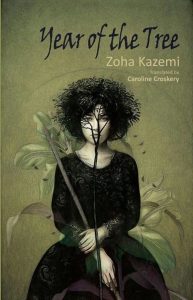

Novel series by Zoha Kazemi
The World of Lollipop-People
Illustrated by: Susan Azari
The story takes place in the far future. After the 5th World War, a peace treaty is signed which would not allow human-beings to harm and kill one another. Humans are divided in to two groups or types: Type A and Type Y (or as the Type As call them, the Lollipop-People). The Lollipop-People are slow-minded, they are short and fat. All they do is eat, drink, sleep and watch a game called “Tik Taak”. They live in big cities that are divided to different districts based on different characteristics (color, shape, etc.) of their favorite “Tik Taak” team. Group As are people who look like us. They are the minority, living in small colonies called countries. They are trained to spend all their lives working and preparing the necessities for themselves and the lollipop-People. Of course Robots play a great role at helping them with all their tasks.
Volume I: The Ambassador of the Lollipop-People Town
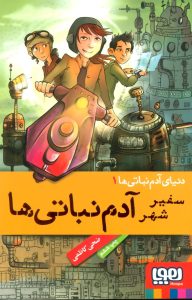
The three teenage characters of the story, Tara, Rama and Pasha, who are born with Type A, are at a critical stage in their lives. They have to choose the country in which they will spend the rest of their lives studying and working. Tara, the narrator of the story, is unhappy with her choice. In an impulsive decision, the three best friends decide to run away to a nearby Lollipop-People town to live their lives as they wish, without the never-ending responsibilities and hard work related to Type A countries. This is where their adventure begins. The journey doesn’t go as they planned with Tara’s foot injury and the unexpected encounter with the 999 Watch Robot. But they finally get there with the help of a mysterious man named Tuma. They make friends with a Lollipop couple named Pany and Muny and watch a “Tik Taak” game. At the same time, they find themselves in a lot of dangerous situations and see many shocking things like the Lollipop-People prison. At the end, the three teenage characters are saved from the Lollipop-People prison and taken to a Type A quarantine where they are questioned and have to redeem their follies. At last they are sent to become ambassadors of the Lollipop-People towns, with the task of helping the Lollipop-People and the young Type As who like themselves might fleet to the towns.
Volume II: The Lollipop-People Mother
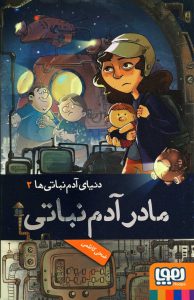
The story of Tara, Rama, and pasha continues in the next volume as they begin their studies as ambassadors of Lollipop-People towns. They are sent amongst their colleagues and their tutor Mifa to a Lollipop-People town to start their first project. Their project is about Lollipop-People children. They experience many touching feelings as they visit the Lollipop-People Kindergartens, the babies and mothers. Rama, the narrator of this volume is unsatisfied with their findings. She has so many questions that she would want to find answers for. Rama requests another visit to complete their project. She asks to go and see the “Birthing Country” where Lollipop-People children are born there. The request is accepted and Tara, Rama, Pasha and their colleague Ania are sent with Pany and Muny to the Birthing Country where Muny is going to give birth. Muny’s child is born and taken away as she is born with Type A! The baby is taken from Muny and has to be raised by the cold feeling robots of the Birthing Country. Rama is angry and with the help of Tara and Pasha plans an escape with the baby. Meanwhile Pasha finds a database of mothers and children. The database contains the name of all mothers, their address and their children’s names and types. Rama’s escape plan goes well at start as the three young characters, Pany, Muny and the new born escape to a different Lollipop-People town. But the baby gets sick and the Police and Doctor Robots catch them all. The baby is taken back to the Birthing Country, Pany and Muny are sent back to their town and the three young adventurers are taken to quarantine again. Before they’re caught, Rama manages to meet with her Lollipop-People mother using the database Pasha had found. She finds her mother but the visit doesn’t go well. The quarantine is longer this time. At the end, Rama is sent to work in a Birthing Country, Pasha is sent to work as a security system developer in the Management Country and Tara is sent back to be an ambassador for Lollipop-People towns. They are all to use their experience and learning and their new ideas for the improvement of theirs countries.
Volume III: The Type A Lollipop Man
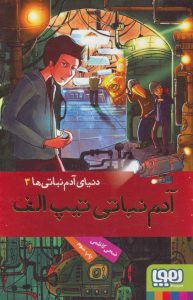
A year has passed since the last adventure of the main characters Rama, Tara and Pasha. Pasha, the narrator of the third volume talks about their new lives in their new countries. The three old friends are separated and each live and work in their assigned countries. But they meet up frequently in the Entertainment Country. At one of these meet ups, Rama talks about a baby who was born with neither Type A or Type Y. the baby was mysteriously taken away from the Birthing Country and vanished from all charts. Pasha promises to look in to it. But he gets engaged with rewriting the security codes of the Book Museum, which was hacked by a man named Lama. Pasha finds out that Lama is held in a permanent quarantine but each year, right before the holidays, mysteriously hacks the security systems of some places like the Book Museum and the Medicine Country. Pasha plans a dangerous mission to go and talk to Lama in quarantine. Lama tells him what to look for and gives him some clues. The clues lead our three youngsters to a new adventure. Following the leads, Pasha, Rama and Tara find their way to a village that is off all charts: The Y.A.5 where a whole different types of people live in, the type YA. That’s where they meet the great leader of the world, a person who is not of any special types. They find out the truth about the way the world works. The truth is bitter. People are all born the same. The leaders (the YA people) decide whether the new born should be raised as type A (9 percent of the population), type Y(90 percent) or type YA(1 percent). Those raised as type Y are given special medicine that makes them subnormal, fat and kills them at the age of 40 without being able to do anything significant in their lives. The type A are given medicine that makes them unable to have children but keeps them healthy and energetic to work, while type YA are living without medicine and ruling the world. The use of medicines and the division of people in to three types are against the peace treaty. Pasha and his friend escape the YA village and take the matter to court. There are ups and downs, quarantines and many documents to be proven. They finally win the case and are able to change the world, making it an equal place for everyone to live in.

A Flash Fiction Collection by Zoha Kazemi

A Novel by Zoha Kazemi

Rama bookstore, owned by Zoha Kazemi was established in June 2020 in Tehran, Bozorgmehr Street. It was established with the aim of creating a center for Iranian speculative fiction writers, translators, and fans. It is a specialized bookshop with a complete collection of science fiction, horror, fantasy, thriller and crime fiction books available in Iran. Rama bookstore website is considered as the main database that has gathered all the published speculative fiction books in the country. Rama also has many exciting and fun accessories for speculative fiction fans such as specially designed mugs, stickers, bookmarks, etc. We hold many fun and interactive events such as book signings, story reading and writing workshops in Rama. It is also the host of an annual speculative short story contest for unpublished writers. Now Rama is more than a bookstore; it is a unique community center in Iran that creates hope for all creative and unrecognized minds.
